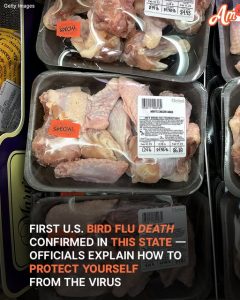

In addition to the LDH confirming the U.S.’s first H5N1 bird flu death and disclosing preventative measures, the CDC has provided updates on the current situation concerning cases.
A few weeks after reporting the first severe human case of highly pathogenic avian influenza (HPAI), otherwise known as H5N1, in the U.S., the Louisiana patient passed away. According to the Louisiana Department of Health (LDH), the patient was over 65 years old and had underlying medical conditions.
Following exposure to both wild birds and non-commercial backyard flocks, the late patient contracted H5N1, which led to their hospitalization. Amid the LDH’s report on the death, the department issued a message to the loved ones of the deceased.

USGS Biologist Science Tech Brooke Hill releases a Western Sandpiper after testing it for the highly pathogenic H5N1 avian influenza in Sonoma, California on August 16, 2006 | Source: Getty Images
“The Department expresses its deepest condolences to the patient’s family and friends as they mourn the loss of their loved one,” they expressed. They also clarified that there will be no further updates or details shared regarding the deceased patient.
In an effort to safeguard the public, the LDH also divulged measures civilians can take to avoid H5N1 infection.
They urge people to avoid sources of exposure, which means that individuals should abstain from coming into direct contact with wild birds and/or any other animal that may be infected with bird flu viruses or suspected of having them.

New England Wildlife Center staff rescuing birds affected by an oil spill in Brookline, Massachusetts on December 9, 2024 | Source: Getty Images
No sick wild animal should be brought into residences, and people should avoid touching them or the droppings of the wild animals and dead ones. The LDH also warns civilians to keep their pets away from the aforementioned wild and dead animals.
Fourth on their preventative measures list is to avoid consuming any undercooked or uncooked food. Eggs, poultry, and other animal products should be cooked to the correct temperature, and individuals should avoid the cross-contamination of cooked and raw food.
People are also urged to inform either the Louisiana Department of Agriculture and Forestry Diagnostic Lab or the USDA toll-free at 318-927-3441 and 1-866-536-7593, respectively, of any sick or dead birds or animals. Those who work on dairy or poultry farms should speak to their medical provider about getting seasonal flu vaccinations.
While it will not make them immune to contracting avian influenza viruses, it may reduce the risk of co-infection with flu and avian viruses. However, the LDH also warns that while the risk of contraction remains low for the general public, those who work with birds, cows, or poultry, or have any recreational exposure to such, stand a greater chance of being infected.
The LDH also notes, “If you have been exposed to sick or dead birds or other animals or work on a farm where avian influenza has been detected, watch for respiratory symptoms or conjunctivitis.”
People who develop symptoms within ten days after exposure to sources should inform their healthcare provider that they have been in contact with sick animals and express their concern about avian influenza.
Doing so will help the medical professional administer the appropriate advice on treatment and testing. “Stay home and away from others while you have symptoms,” adds the LDH.
Aside from disclosing steps of prevention and the grim news about the U.S.’s first H5N1 death, the LDH has confirmed that they found no evidence of person-to-person transmission or additional cases apart from the ones that have been reported following their extensive public health investigation.
On the matter of the current situation regarding cases, the Centers for Disease Control and Prevention (CDC) have reported a confirmed total of 66 human cases in the U.S. during the 2024 outbreak. Several recent cases have been prevalent in U.S. dairy and poultry workers.
The human cases are spread across the states of California, Colorado, Iowa, Louisiana, Michigan, Missouri, Oregon, Texas, Washington, and Wisconsin.
Regarding the exposure sources, of the 37 cases in California, 36 are reported to have come from dairy herds (cattle), and one has an unknown exposure source. There are ten cases in Colorado, one of which stems from dairy herds (cattle), and nine come from poultry farms and culling operations.

A cattle ranch in Panama in 2024. | Source: Getty Images
The one case in Iowa’s exposure source is reported to be from poultry farms and culling operations, while the one in Louisiana (the case where the patient died) is from other animal exposure.
Michigan’s two cases stem from dairy herds (cattle), and the one case in Missouri has an unknown exposure source. Oregon and Wisconsin both have a case each with an exposure source of poultry farms and culling operations.
The exposure source for Texas’ case is dairy herds (cattle), and all 11 of Washington’s cases stem from poultry farms and culling operations. Additionally, the CDC reports that as of January 3, 2025, H5N1 bird flu has been detected in 10,922 wild birds.
Before divulging the current data — which the CDC makes clear is subject to continuous updates as the situation progresses — and sharing the news about the first death as a result of the virus, an investigation was underway to identify the source of the Louisiana patient’s H5N1 bird flu infection.
At that time, before the exposure source was confirmed, the patient was believed to have come into contact with deceased birds from backyard flocks. This marked the first reported U.S. case of H5N1 bird flu connected to backyard flock exposure.
Genomic analysis of the H5N1 bird flu virus from the Louisiana patient showed that it belongs to the D1.1 genotype, linked to recent detections in wild birds and poultry in the U.S. and human cases in Canada and Washington.
This differs from the B3.13 genotype seen in dairy cows, some human cases, and poultry outbreaks. At the time, the CDC was conducting further genomic sequencing and virus isolation from the sick patient.
A single severe H5N1 bird flu case in a person is not unusual, as this virus has caused serious illness and fatalities in other countries. The CDC has maintained that the overall public health risk from H5N1 bird flu is low.
Nevertheless, California Governor, Gavin Newsom, declared a State of Emergency to expedite the state’s response to H5N1 bird flu after cases emerged in Southern California dairy cows.
The virus has spread across 16 states since its first confirmed detection in Texas and Kansas on March 25, 2024. Bird flu was first identified in the U.S. wild bird population in South Carolina in January 2022, followed by California in July 2022.
An outbreak in dairy cows was reported in Texas and Kansas, prompting CDFA to monitor California herds. Last month (December 2024), 61 confirmed human cases were reported across seven states, including 34 in California.
Newsom explained that the declaration of a State of Emergency enables greater flexibility in staffing, contracts, and containment measures. He informed the public that California has implemented the nation’s most extensive testing and monitoring system to address the outbreak.
The governor shared, “We are committed to further protecting public health, supporting our agriculture industry, and ensuring that Californians have access to accurate, up-to-date information.”

California Governor Gavin Newsom speaks during a press conference in Los Angeles, California, on October 27, 2024 | Source: Getty Images
As the government works to enhance public health, people have been urged to reduce their risk of H5N1 exposure. If exposure is unavoidable, personal protective equipment (PPE), such as gloves, safety goggles, N95 respirators, and disposable coveralls, should be worn to minimize risks.

Jon Arizti Sanz, PhD, Postdoctoral Fellow testing purchased milk at area grocery stores for the presence of bird flu, in Cambridge on May 14, 2024 | Source: Getty Images
For poultry and livestock workers, employers are encouraged to update workplace health and safety plans to address potential H5N1 exposure. They should also conduct hazard assessments to identify high-risk tasks.
Additionally, when employers implement control measures, such as isolating infected animals and ensuring proper hygiene, they can significantly reduce risks.

Ducks with bird flu also known as poultry flu are collected and put in a container in Zarnewanz, Germany on November 28, 2024 | Source: Getty Images
Workers should also be provided with appropriate Personal Protective Equipment (PPE) to safeguard against contact with infected animals or contaminated materials. By following these recommendations, the spread of H5N1 can be effectively mitigated.


